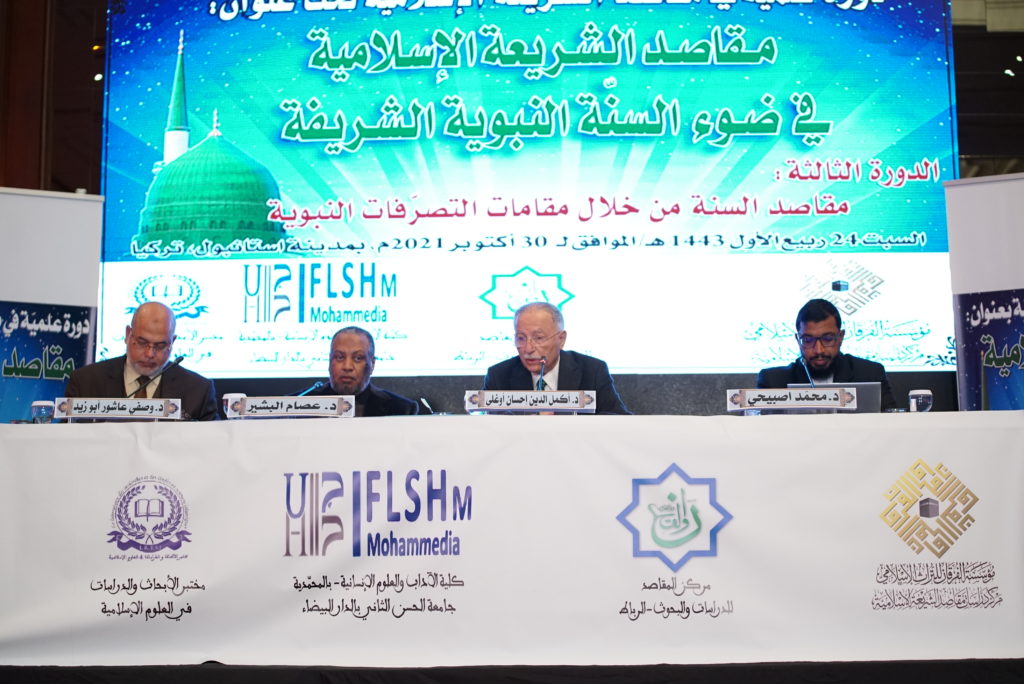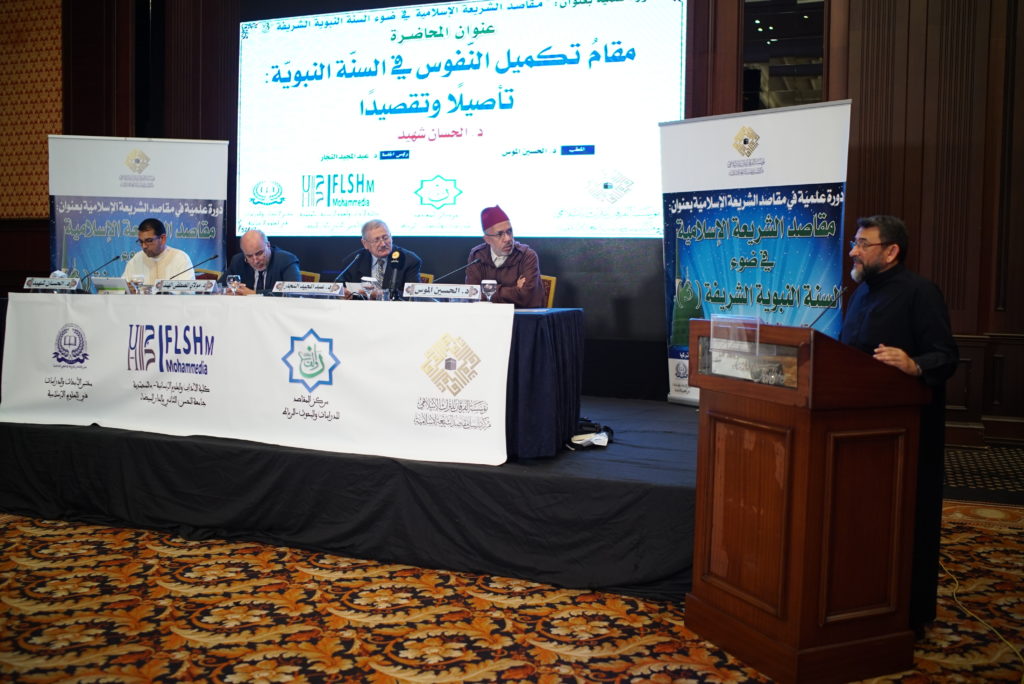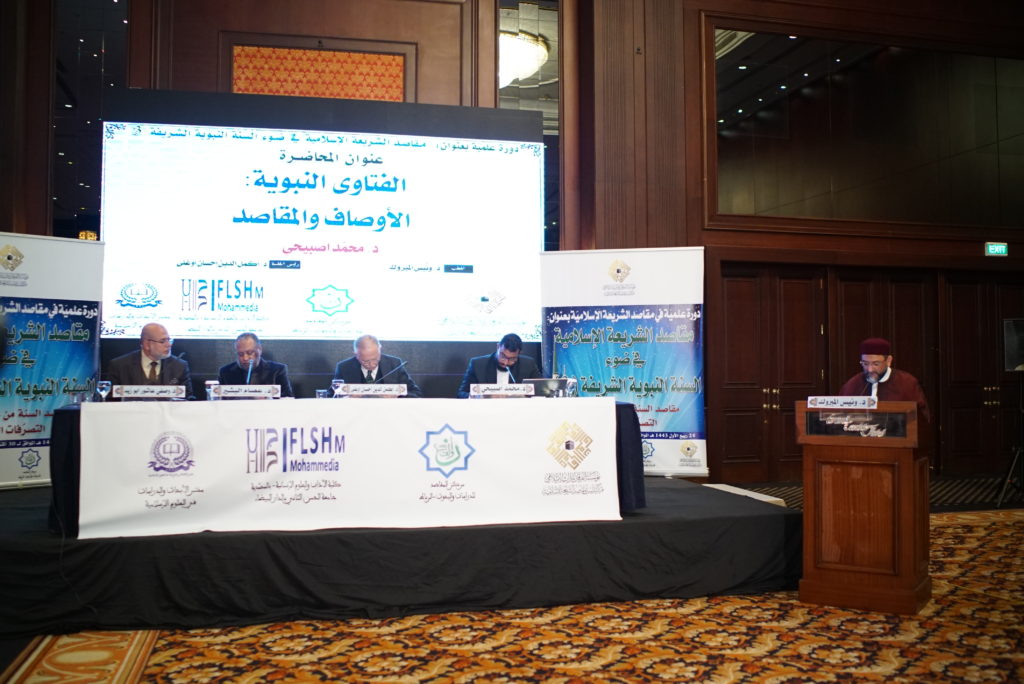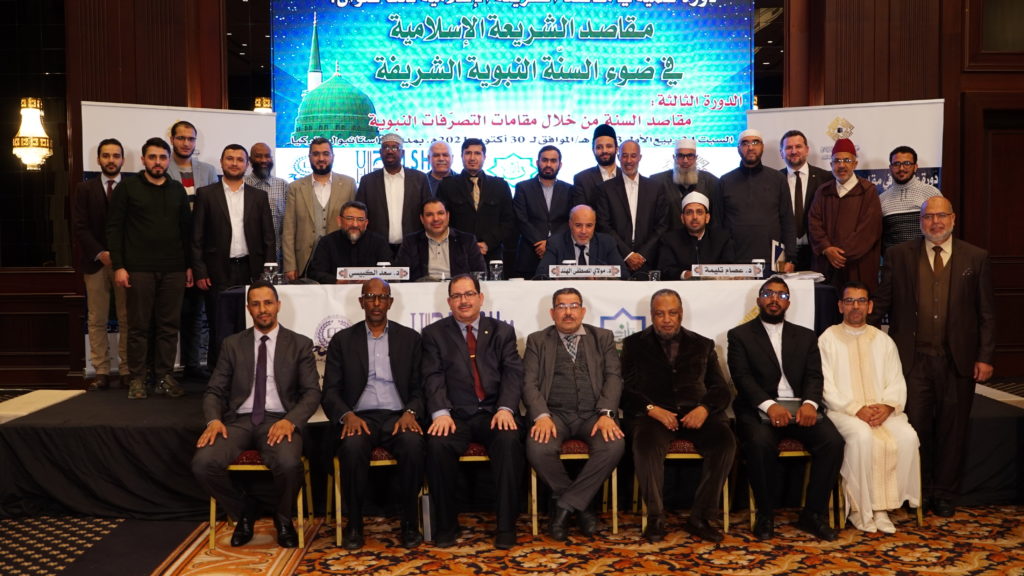The third scientific course under the title “The Objectives of Islamic Law in Light of the Noble Prophetic Sunnah"
The third training course on “The Objectives of Islamic Law in Light of the Noble Prophetic Sunnah from the Perspective of Capacities (maqāmāt) of Prophetic Actions (taṣarrufāt)” was convened with the aid and blessing of Allāh, Most High, on Saturday, 30 October 2021CE (24 Rabī‘ al-Awwal 1443AH), in the welcome surroundings of Grand Cevahir Hotel in Istanbul, Turkey. This was the culmination of the two previous training courses, held in the Kingdom of Morocco, on the topic. This training course was organised by Al-Furqān Islamic Heritage Foundation - Centre for the Study of the Philosophy of Islamic Law, the Maqasid Research & Studies Centre in Rabat, and the Research and Studies Laboratory in Islamic Sciences at the Faculty of Arts and Humanities in Mohammedia, Morocco.
Opening Session
The first session opened with illuminating verses from the Glorious Qurʾān recited by Mr. Moulay al-Hassan Al-Barhoumi. Subsequently, Mr Sali Shahsivari, Managing Director of Al-Furqān Islamic Heritage Foundation, welcomed the esteemed audience, and explained the importance and timeliness of the training course—as the conclusion of previous examinations of the Prophetic Sunnah’s objectives. He underscored the importance of these scientific training courses in laying the foundation for sound understanding, correct emulation, suitable fitting to novel cases, and proper application, so as to draw inspiration from the Noble Prophetic Sunnah in finding solutions to the flawed aspects of religious practice, and the negative effects of civilising endeavours, especially in these contemporary times.
He was followed by Dr Al-Husayn Al-Mous, Deputy-Director of the Maqasid Centre for Research & Studies, who concentrated on explaining the importance of these training courses in prompting communication between students of knowledge and scholars, enabling them to engage in sound consideration of novel developments of the times. He praised the partnership between the Maqasid Centre for Research & Studies and Al-Furqān Islamic Heritage Foundation, expressing hope in seeing broader research horizons addressed in forthcoming training courses, especially in the area of objectives of beliefs (maqāṣid al-‘aqāid).
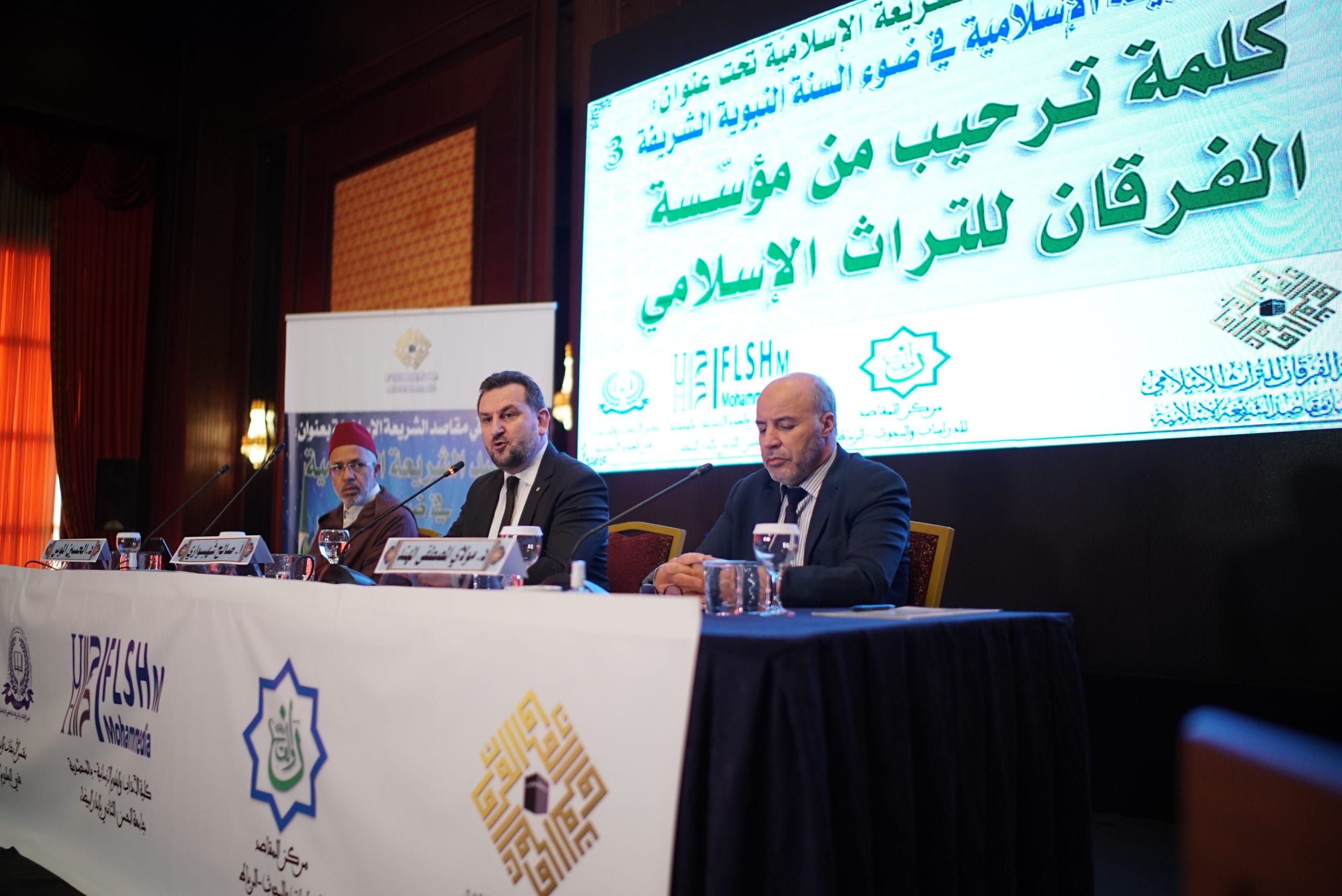
The first session opened with illuminating verses from the Glorious Qurʾān recited by Mr. Moulay al-Hassan Al-Barhoumi. Subsequently, Mr Sali Shahsivari, Managing Director of Al-Furqān Islamic Heritage Foundation, welcomed the esteemed audience, and explained the importance and timeliness of the training course—as the conclusion of previous examinations of the Prophetic Sunnah’s objectives. He underscored the importance of these scientific training courses in laying the foundation for sound understanding, correct emulation, suitable fitting to novel cases, and proper application, so as to draw inspiration from the Noble Prophetic Sunnah in finding solutions to the flawed aspects of religious practice, and the negative effects of civilising endeavours, especially in these contemporary times.
He was followed by Dr Al-Husayn Al-Mous, Deputy-Director of the Maqasid Centre for Research & Studies, who concentrated on explaining the importance of these training courses in prompting communication between students of knowledge and scholars, enabling them to engage in sound consideration of novel developments of the times. He praised the partnership between the Maqasid Centre for Research & Studies and Al-Furqān Islamic Heritage Foundation, expressing hope in seeing broader research horizons addressed in forthcoming training courses, especially in the area of objectives of beliefs (maqāṣid al-‘aqāid).
In turn, Dr Moulay al-Mustapha al-Hind, Director of the Research and Studies Laboratory in Islamic Sciences at the Faculty of Arts and Humanities in Mohammedia, Morocco, clarified the importance of the training course’s topic, namely the examination and analysis of the Sunnah’s objectives from the perspective of the capacities from which Prophetic actions emanated. He noted that such examination was the preserve of erudite scholars, with extensive experience in the objectives discipline, through theorising, inductive reasoning (al-istiqrā’), and fitting to novel cases (tanzīl). Indeed, attempting to understand Islamic legal rulings and objectives without referencing Prophetic actions and capacities is a path to error. He stressed that, given the contributions of participating scholars and intellectuals, this blessed training course was well-placed to answer many burning questions; the answers to which would contribute to paving the way for the Muslim nation’s civilising resurgence.
The First Session chaired by Dr Ekmeleddin İhsanoğlu
The first session opened with the Dr Issam Ahmad al-Bashir’s paper on “The objectives of Prophetic actions in leadership”, where he addressed Prophetic actions in the capacity of leader (imām). He traced the trajectory of scientific grounding of the topic on the principal sources of evidence, where he raised the problematic epistemological issue relating to Islamic political thought. He noted that this problematic issue is tied to the “method adopted in rational consideration of these [Prophetic] actions, and the approach to classifying them in the Islamic legal context, as either perpetual legislation, or time-bound ruling (ḥukm) based on an interest (maṣlaḥah). Dr Issam al-Bashir built his paper on a sound, robust methodology based on Islamic law objectives and referral to the principal sources of Islam (ta’ṣīl), which combined the permanence of universal principles and objectives, and the variability of forms in a methodology linked to origin and connected with the times.
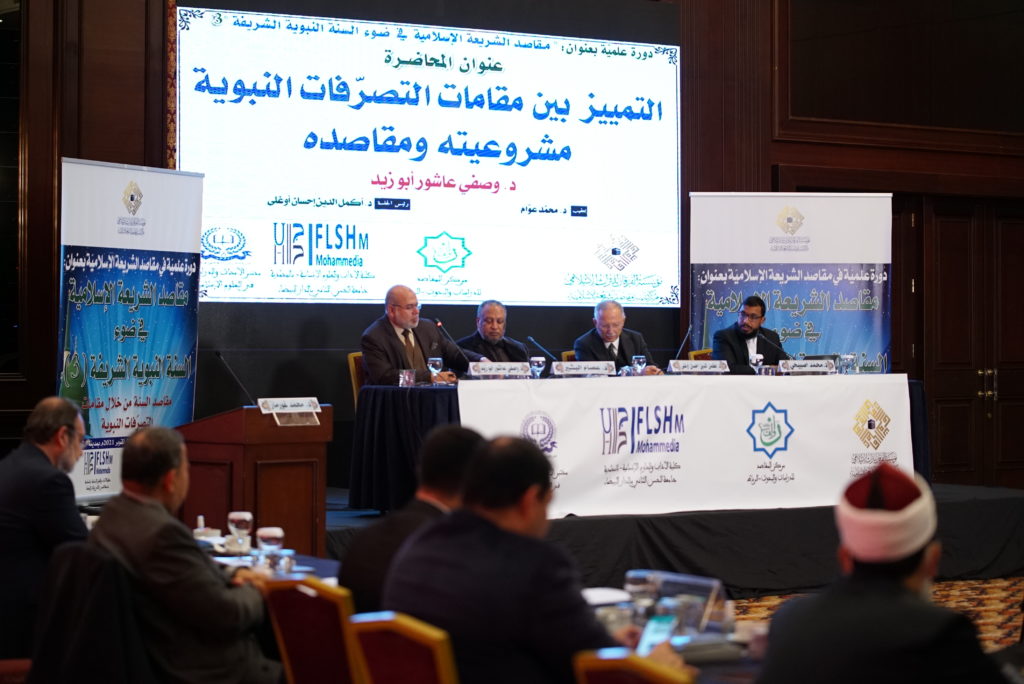
The lecturer also treated the concept of imāmah or leadership, in terms of semantics (dalālāt) and conceptual relationships. He stated that our Prophet, peace and blessing upon him, embodied two kinds of leadership; the first, leadership by virtue of Revelation (waḥy), i.e. Prophethood, and the second, leadership of the Muslim nation (ummah). He also touched upon the concept of Islamic governance (al-siyāsah al-shar‘iyyah), emphasising the importance of objectives (maqāṣid) in understanding Prophetic actions in the capacity of leader. Further, he explained that the criterion for discerning a capacity was to identify the objectives. In this context, he quoted a set of rules developed by the scholars, concluding with the practical aspect.
In the context of elucidating leadership or imāmah, Dr Issam al-Bashir addressed its attributes and determinants, restricting these to seven, namely that it: is a description additional to Prophethood; is intimately linked to public interests; integrates legislative and executive action; accommodates both permanent principles and varying rulings; is based on creative juristic effort (ijtihād) that considers time, place, custom (al-‘urf), and circumstances (al-ḥāl); obliges emulation and following of the Prophet, peace and blessing upon him, in taking proper account of the objectives of his actions aimed at securing and complementing interests, rather than particularities of rulings; furthermore, acting by virtue of leadership is conditional on the leader’s permission.
Subsequently, Dr Issam addressed the contexts of Prophetic actions in the capacity of leader. In his view, these included the domains of ritual worship (‘ibādāt), financial transactions, penalties, Islamic governance, and foreign relations.
He followed with treatment of Prophetic actions in the capacity of leader from referral to the principal sources of Islam, to determining effective causes (taḥqīq) and fitting to novel cases (tanzīl); he grounded this on important rules, namely: societal consensus; reinforcing human commonality; entrenching consultation (shūrā) and its practice; the Muslim nation as the source of political legitimacy; the State between permanence of principles and variability of forms; and the fallibility of rulers’ creative juristic effort (ijtihād). He concluded his paper by speaking about the Prophetic actions in the capacity of leader from eliciting rules and referral to principal sources to a standard governing framework.
Dr Mehmet Görmez commented on the paper, emphasising its importance and the excellence shown by the author in addressing, ordering, and robustly presenting the subject material. He began by classifying leadership (imāmah), then eliciting a comprehensive definition for Islamic governance, making leadership a description additional to Prophethood, and not intrinsic to it. He then stated that each of the sayings of the Messenger, peace and blessing upon him, must be understood within the frame of the wisdom from creating life, the reason for man’s existence, and the aims of sending down religion. In this consideration, objectives and interest (maṣlaḥah) signify understanding the Prophetic meaning and objective, the human-religious benefit, and the Divine Aim of that Prophetic act or statement; as, indeed, the objectives are the spirit of Islamic jurisprudence (fiqh) and the quest of creative jurists (sing. mujtahid).
Dr Mehmet Görmez classified the objectives of the Sunnah into two kinds: general (‘āmah) objectives, such as wisdom, tolerance, moderation… and specific (khāṣṣah) objectives, namely the aims of Islamic law in all spheres of political, economic, and family life. Dr Görmez did not forget to mention the ways of understanding the noble Prophetic tradition (ḥadīth), emphasising the importance of taking account of particular and internal contexts. The objective of all this, as he said, is that our noble scholars were keen for the Sunnah be understood in an integrated, rather than a partial and fragmented manner.
This was followed by Dr Wasfi Ashur Abu Zaid’s paper titled “Distinguishing the capacities of Prophetic actions: legal validity (mashrū‘iyyah) and objectives—a reading in light of the statements and acts of the Prophet, peace and blessing upon him, and the understanding and actions of the Companions”. The paper opened with an introduction, in which he explained its importance, in his words, manifested in “that it lays a legal theory foundation confirming the evidential validity (ḥujjiyyah) of such a distinction”. He indicated that the research problem is manifested in that “there is a trend in legal theory that considers the Sunnah in its entirety as permanent and obligatory legislation; this trend exists in both past and present”.
The paper comprised an introduction, where he explained the terms used to compose the title, namely legal validity (mashrū‘iyyah), distinction (tamyīz), capacities (maqāmāt), and actions (taṣarrufāt), from which he constructed his intent from the paper’s title. He followed with three areas of inquiry:
The first was dedicated to legislative actions, encompassing three branches; the first elucidating permanent and obligatory actions; the second on legislative actions, of which some are non-general and non-permanent; and the third on those actions that were initiated based on the Prophet’s own creative juristic effort (ijtihād), which the Revelation subsequently corrected.
The second area of inquiry addressed non-legislative actions, where he presented 18 incidents or actions expressed the Messenger’s sayings and actions, and those of the Companions. Concurrently, he explained that the Companions, may Allah be pleased with them, understood this, i.e. distinguishing between the legislative and the non-legislative.
In the third area of inquiry, he clarified the objectives of distinguishing between Prophetic actions, which he classified into six, namely:
First, securing the correct understanding of the Prophetic Sunnah.
Second, determining the objectives of the Prophetic Sunnah.
Third, recognising permanent legislation from that predicated on an effective cause (‘illah).
Fourth, soundness of evidencing (istidlāl) from the Sunnah and creative juristic effort (ijtihād).
Fifth, discriminating between that which is, and that which is not of the religion.
Sixth, emphasising the human nature of the Prophet, peace be upon him.
He concluded his paper with important recommendations, namely revising explicatory texts (shurūḥ) of the Sunnah according to this standard, and reviewing the fatwas issued by our esteemed scholars throughout history, and evaluating these on this scale and standard. He also recommended that this issue be included in charters for issuing fatwa and creative juristic consideration (ijtihād), and hence, visible to muftis and creative jurists (sing. mujtahid).
Dr Mohamed Aouam commented on the paper, focusing on explaining the importance of the topic of Prophetic capacities and actions, given the problematic issues it raises, and the dysfunctions it treats. He emphasised the matter of finalising the definition of the concept of Prophetic actions. He posited that the concept of the Sunnah, despite differences due to scholars’ specialisation, is distinct to the concept of Prophetic actions, which in his words is particular to a specific type of Sunnah, especially that related to obligation, and administration of public affairs, such as leadership (imāmah), adjudication (qaḍā’), and fatwa issuance (iftā’). Subsequently, he clarified the types of distinctions in Prophetic actions, such as through textual evidence (naṣ), creative juristic effort (ijtihād), and contextual circumstances (aḥwāl). He then addressed the standards and rules for making such distinctions.
This was followed by the paper titled “Prophetic fatwas: descriptions and objectives” by Dr Mohamed Sbihi. He structured his paper around two areas of inquiry, each addressing two purposes. In the first area of inquiry, he addressed the topical and style descriptions characterising Prophetic fatwas. He classified these into seven descriptions; first, Divine nature (rabbāniyyah), meaning that the actions of the Prophet, peace and blessing upon him, from the perspective of fatwa, originate from Allāh, the Almighty, and that the Prophet, in his fatwa, is transmitting from Allāh, the Almighty. Second, freedom from inconsistency and contradiction, meaning that Prophetic fatwas do not compete with, or undermine each other, because their source is Allāh, the All-Knowing, the Expert, the All-Wise. Third, obligatory nature, because the person seeking the fatwa is obliged – religiously – to abide by the fatwa issued by the Prophet, peace be upon him; it is not permissible to act contrary to the Prophetic fatwa as it is from Allāh, in the first instance or by way of subsequent endorsement. Fourth, comprehensive and human-centric, i.e. the Prophetic fatwas are inclusive of different topics on creed, ritual worship, ethics, and transactions. Fifth, universality and permanence, meaning that the actions of the Prophet, peace be upon him, in the capacity of mufti, were not temporary and time-bound, where after him these are repealed and cease to exist; furthermore, these are not specific to those individuals soliciting the fatwa, but are permanent, and part of ritual worship to the Day of Judgement, and generalised to others. Sixth, practical and realistic, in that the researcher referred to the fact that Prophetic fatwas were responses to novel developments and issues from reality, where religious need compelled finding the ruling; indeed, these were not answers to hypothetical “if” questions. Seventh: moderation or balance as a description means they follow the middle way in belief, and actions, and in both ritual and mundane matters.
As for style descriptions of Prophetic fatwas, the researcher determined these to be: first, clarity, where Prophetic fatwas came to clarify those rulings on which the Prophet, peace and blessings upon him, was queried, using the clearest phrases and most precise wording. Second, succinct without deficiency, and expanded without inconsistency or unnecessary repetition. Third, diversity in forms of response; the Prophet, peace and blessings upon him, sometimes responded using an informational statement, sometimes the imperative, and at times, an interrogative confirmation providing both answer and effective cause. Fourth, matching or implication: by which the researcher meant that the Prophetic answer would match the question, or the Prophet, peace and blessing upon him, would state general rules, principles, and universals that—inevitably—address the question posed by the individual and others. Fifth, adding benefit: meaning that the Prophet, peace and blessing upon him, when asked on an issue, may add to the answer something that the person soliciting the fatwa had not asked for, where this is connected to the issue, and circumstantial clues indicate that the individual needs it. Sixth, logical causation and evidencing: it is noticed in the fatwas of the Prophet, peace and blessing upon him, that he may sometimes merely mention the ruling, where it is a matter of ritual worship, or where the effective cause and wisdom are clear, or because the questioner is incapable of comprehending the effective cause; at other times, he would mention the rationale of the ruling, present parables, and employ resemblances (ashbāh) and similitudes (naẓā’ir).
With respect to the second area of inquiry, the researcher addressed the Islamic legal and methodological objectives of Prophetic fatwas. The Islamic law objectives of the Prophetic fatwas included preserving the necessities (al-ḍarūriyyāt), namely faith, life, intellect, progeny, and wealth. Moreover, these encompassed the objective of promoting ease (taysīr) and eliminating constraints (ḥaraj), whether in the matters of ritual worship (‘ibādāt), transactions (mu‘āmalāt), or customs (‘ādāt). The researcher also determined that Prophetic fatwas embodied objectives classed as improvements (taḥsīniyyah), the objective of freeing the person charged with religious duty (al-mukallaf) from bondage to their own desire, and the objective of blocking (sadd) and opening (fatḥ) the means (al-dharāi‘).
In addressing methodological objectives, the researcher mentioned the objective of imparting understanding as a valid objective in Prophetic fatwas. In addition, the objectives of: ensuring cognitive acquisition; persuading compliance and satisfaction with the ruling; and providing guidance to muftis after the Honourable Prophet. He concluded the paper with the invitation to adopt Prophetic fatwas, both as a methodology, and in fitting to novel cases, while recommending the treatment of distortions in contemporary fatwas, in light of the foregoing.
Dr Wanis al-Mabrouk commented on, and praised the paper as an important study in the subject area. It contributed to eliciting the objectives dimension in Prophetic fatwas, where the researcher addressed some of the descriptions and objectives of Prophetic fatwas, which assist in reducing the incidence of laxity and deviance in fatwas. Moreover, the paper included questions and scientific terms suitable for expanded treatment in further studies. Dr Wanis mentioned that Prophetic fatwas were a response to a question from actuality, or an expected, emergent matter; however, in his words, they were always an expression of the Noble Qur’ān’s objectives, and assured the interests of Allāh’s servants. In his opinion, it embodied a methodology worth following by the Prophets’ inheritors, i.e. the scholars, and anyone issuing fatwas. Subsequently, he articulated the paper’s distinguishing features, while voicing some criticisms, including that it was packed with beneficial scholarly questions, and substantial issues that were subject to extensive contention in jurisprudence and legal theory texts.
Second Session chaired by Dr Abdul Majid al-Najjar
On behalf of Dr Fahd bin Saad al-Zaydi al-Juhani, Dr Moulay al-Mustapha al-Hind proceeded to present a reading of the paper titled “The objectives deduced from the actions of the Noble Prophet, peace and blessing upon him, in adjudication (qaḍā’) and reconciliation (ṣulḥ)”. In the introduction dedicated to illustrating the importance of the topic, the researcher indicated that “knowing the kind of action or saying from the aspect of differing capacity, assists in understanding the religious text, and applying it correctly as evidence”. Dr Fahd divided his paper into two main areas of inquiry; the first dedicated to elucidating the meaning intended by Prophetic actions, and the criterion for distinguishing between them. Subsequently, he defined adjudication, which, in his words is: informing of, and imposing, the Islamic legal ruling. In the second area of inquiry, he mentioned examples of actions of the Noble Prophet in adjudication and reconciliation, deducing the inherent objectives and wisdoms. He counted seven examples, each linked to its objectives, as follows:
First: His adjudication, peace and blessing upon him, on the one marrying off his daughter against her wishes.
Second: His adjudication, peace and blessing upon him, on taking from the miserly husband’s money in reasonable measure, without his knowledge.
Third: His adjudication, peace and blessing upon him, on contracting marriage by agency.
Fourth: His adjudication, peace and blessing upon him, on division of water shares.
Fifth: Prophetic reconciliation (ṣulḥ)
Sixth: On annulling unlawful reconciliation, and ruling otherwise
Seventh: His adjudication, peace and blessing upon him, on child custody
Dr Fahd al-Juhni concluded his paper with important recommendations, namely that “the universal matters and mandatory rules, which help judges and their assistants to perform sound judicial juristic effort, are realised by applying the Islamic legal ruling to its correct setting and relevant incident; furthermore, taking into account (i.e. the juristic effort) the specificity of each incident, and related circumstances and diverse inputs, which may sometimes compel changing from one ruling to another or from preponderant (rājiḥ) to less preponderant (marjūḥ); these universal rules, or as some researchers call them, the principles of description (uṣūl al-tawṣīf), are very important, and must be comprehended, and taken into consideration”.
After reading a summary of the paper, Dr Moulay al-Mustapha al-Hind commented on it, pointing to the effort expended by Dr Fahd. Furthermore, elucidating the importance of the topic, where in Dr Fahd’s opinion, any shortcoming in linking the objective to the Prophetic action may lead to results that are unsuitable for analogy or application. Furthermore, comprehending rulings must be based on the understanding of the objectives of Prophetic capacities and actions.
In his commentary, Dr Moulay al-Mustapha al-Hind reported that the treatment of Prophetic actions, in terms of inductively-reasoning the objectives, requires patience in ruling, precision in description, and sound application and generalisation, with knowledge of the types of actions and capacities; hence, determining which of these circumstances’ objectives are suitable to be used in analogy, and whether these objectives are universal (kullī) or partial (juz’ī), original or subordinate, or certain (qat‘ī) or surmised (ẓannī). Indeed, deducing the objective from the action, and formulating a specific description is not an easy or straightforward matter. Dr al-Hind made a number of critical observations enriching the discussion and deepening examination of the issue presented; this included, in his words, lack of clarity regarding the issue of the Sunnah, in terms of the universality of its legislation, which is subject of disagreement, in both past and present.
This was followed by Dr al-Hassan Shahid’s paper, “Perfecting selves in the Prophetic Sunnah: referring to principal sources and discerning the objectives”. The paper was structured around six areas of inquiry. In the first, he addressed the meaning of perfecting selves and its position, concluding based on Ibn ‘Āshūr’s view that it is “taking the selves of those charged with religious duty to the most perfect levels in the Prophetic discourse, with the objective of purifying and edifying on the most meritorious qualities, by way of rising in level to bear the duties of Islam, and sound compliance with its rulings”.
In the second area of inquiry, Dr Shahid addressed “perfecting selves in the Prophetic discourse”, in its connection to the Companions, as well as commands and prohibitions in the Islamic legal discourse. In his words, this was demonstrated by the Companions in four aspects, namely betterment through:
- concern for Allāh’s rights, by performing abundant acts of worship, being assiduous in this regard, and avoiding prohibited acts
- concern for, and protecting the rights of Allāh’s servants, and sustaining mutual bonds
- purifying and holding the self to account, driving it to adopt the most meritorious qualities
- acting with excellence (iḥsān) towards the rest of existence
As for perfecting selves in commands and prohibitions in the Islamic legal discourse, he drew attention to the fact that legal theorists (al-uṣūliyyūn) did not make any distinction between the commands of the Qur’ān or Sunnah in terms of their semantics, rather they granted them the same significance. The third area of inquiry related to perfecting selves in the Prophetic commands, in which he touched upon the question of whether Prophetic commands implied obligation (wujūb)? He presented the views of legal theorists, selecting the majority view as the most preponderant, in that these, indeed, imply obligation, based on lexical, practical, and rational arguments. Subsequently, he mentioned examples of commands for perfecting selves, followed by the prohibitions.
The fifth area of inquiry treated perfecting selves and its connection to the remaining Prophetic capacities. He opened with a key epistemological question, namely: is perfecting selves an independent capacity? Here the researcher raised an important problematic issue relating to capacities, in light of which he distinguished between the capacity and the objective. He explained that the essence of the capacity was what al-Qarāfī exclusively presented. On the other hand, the expanded definition offered by Ibn ‘Āshūr was that of cases with objectives. He concluded by saying: “the capacity (maqām) is a function (waẓīfah) and an effective cause (manāṭ) for action, while the objective (maqṣad) is a result and aim for each action; moreover, if each capacity has an objective, then it does not strictly follow that each objective has its own specific capacity”. He opined that these cases may be classified into two kinds; the first, comprising functional, practical capacities, and the second, additional, moral objectives.
In the sixth area of inquiry, the lecturer addressed the rules related to the objective of perfecting selves; he counted 33 rules, which he elicited from the sayings of legal theorists, and represented these as governing rules.
He concluded his paper with recommendations, including:
1. The edification objectives underlying the Prophetic capacities, where broader consideration is given to eliciting the edification objectives from the four principal capacities, namely legislation (tashrī‘), adjudication, leadership, and fatwa, each capacity manifested singly or in combination.
2. The ethical dimension of the four principal Prophetic capacities, namely legislation, adjudication, leadership, and fatwa, where the rank of noble manners is explored in discerning the Islamic law objectives, while performing sound consideration of the nature of manners recognised in this regard.
3. Ways of exploiting the objective of perfecting selves in the Islamic discourse in reforming scientific and educational systems, and contemporary teaching curricula; indeed, the Prophetic guidance, as we know it, holds much promise in this regard.
4. Linking the rulings of concession (rukhṣah) and strict original (‘azīmah) with the objective of perfecting selves, through studying the sources of strict original, and effective causes of concession in edifying the person and purifying the self, taking cues from the Prophetic guidance.
5. Methods of detecting the objective of perfecting selves in Islamic discourse, whether Qur’ānic or from the tradition (ḥadīth), by elucidating the approaches of legal theorists, jurists, and traditionalists (muḥadithūn).
6. A scientific study clarifying, explaining, and expanding the governing rules for the objective of perfecting selves, grounded on the explicit and implicit objectives of the Prophetic discourse.
Dr al-Husayn al-Moos commented on the paper, concentrating on the importance of understanding the Prophetic Sunnah, to avoid falling into error. After summarising the research idea, and introducing the key points developed by the researcher, he presented Dr al-Hassan Shahid’s idea regarding non-independence of the additional capacities proposed by the erudite Ibn ‘Āshūr. He highlighted that many scholars have opined that these are independent. In his commentary, Dr al-Moos emphasised the difficulty of distinguishing between capacities and objectives, due to the overlap between both, illustrating this through examples.
Third Session
The Third Session chaired by Dr Moulay Mustapha al-Hind opened with the paper by Dr Issam Talima, titled “The Prophetic Sunnah in three contemporary books”. The paper focused on presenting a summary of key ideas and methodology employed in three important works that treated questions and problematic issues related to the understanding of the Prophetic Sunnah. The first book was “The Prophetic Sunnah between jurists and traditionalists”, authored by the late Shaykh Muhammad al-Ghazali, may Allāh have mercy upon him. The second, “How to deal with the Prophetic Sunnah… features and governing rules”, by Dr Yusuf al-Qaradawi. The third, “The problematic issue of dealing with the Prophetic Sunnah”, by the late Dr Jaber Taha al-Alwani, may Allāh have mercy upon him.
The first book by Shaykh Muhammad al-Ghazali, may Allāh have mercy upon him, was one of those books that sparked strong controversy and huge discussion among scholars and researchers. Dr Issam Talima explained that the objective of the book was that Shaykh Ghazali aimed to purify the Sunnah, in particular, and the religion of Islam, in general, from those views that were not founded on a universal perspective of Islam… In this way, he refuted those secularists, who rejected this Sunnah, as well as extremist fundamentalists, lacking understanding; he stated: “my aim is to purify the Sunnah from any impurity”.
Dr Issam Talima then began to articulate al-Ghazali’s approach in the book, which revolved around the following principles:
1. Soundness of both chain of narration (sanad) and body (matn). 2. Understanding the Qur’ān first. 3. No Sunnah without jurisprudence (fiqh), and no jurisprudence without Sunnah. 4. Understanding the allegorical verses (mutashābihāt) of the Qur’ān in light of the decisive verses (muḥkamāt). 4. Understanding the particulars (juz’iyyāt) in light of the universals (kulliyyāt). 6. Distinction between aim and means. 7. Distinguishing between ritual worship and customs. Dr Issam Talima began to explain these principles by presenting the examples provided by the book’s author, Shaykh Muhammad al-Ghazali, may Allāh have mercy upon him. The researcher concluded that the book was witness to the rare courage possessed by al-Ghazali in addressing such issues in the Prophetic Sunnah; indeed, there were those who had changed their opinions, after they had been opposed to his views, which are dispersed in his other books. However, he recorded a point of criticism in that the author was too hasty in criticising some traditions, without referring to other scholars in this regard.
The second book examined by Dr Issam Talima was “How to deal with the Prophetic Sunnah… features and governing rules” by Shaykh Yusuf al-Qaradawi. This came in the context of addressing the uproar caused by al-Ghazali’s book. The researcher presented a brief summary of the book in terms of its chapters and sections, then began by presenting the governing rules and features for understanding the Prophetic Sunnah, which were eight in number, as follows:
First, understanding the Sunnah in light of the Noble Qur’ān. Second, gathering the traditions on the single topic. Third, reconciling or judging the preponderance of differing traditions. Fourth, understanding the traditions in light of contextual circumstances and objectives. Fifth, distinguishing between the changing mean and invariable goal. Sixth, distinguishing between the literal and figurative in understanding the tradition. Seventh, distinguishing between the unseen (al-ghayb) and the seen (al-shahādah). Eighth, verifying the semantic meanings of the tradition’s words.
Dr Issam Talima elucidated the importance of the book, in terms of the positive reception by both specialists and the general public. He attributed this to the fact that Shaykh Yusuf al-Qaradawi was one of those scholars, who had combined between tradition and rational consideration. However, the researcher recorded a point of criticism that Shaykh al-Qaradawi did not address the legislative and non-legislative Sunnah, passing over it with brevity.
The third book examined by Dr Issam Talima was “The problematic issue of dealing with the Prophetic Sunnah”, by the late Dr Jaber Taha Fayad al-Alwani, may Allāh have mercy upon him. He clarified that Dr Taha criticised the traditionalists in that they were more concerned with the chain of narration (sanad) rather than the body of the tradition (matn). He also criticised the so-called “Qur’ānists”; in his opinion, “the true Qur’ānist cannot deny the Sunnah, or rule according to his reflections and desires; accepting what he likes, and rejecting what he does not”. Dr al-Alwani touched upon the problematic issues related to the Sunnah, namely: 1. The problematic issues in the legal theory heritage. 2. Hegemony of the jurisprudential approach in dealing with the Prophetic Sunnah. 3. Monopoly of the methodology of narration chains (isnād); he also addressed the question of whether the Sunnah was exclusively concerned with legislation, and clarifying that the Sunnah no doubt contained legislation, but was not concerned solely with this; he views the Sunnah as explanatory, even if it has the nature of obligation alongside explanation; yet it revolves in the orbit of being explanatory.
Among the matters that the researcher elicited from Dr Taha is Prophethood and its functions in the Qur’ān; the Sunnah between concept and terminology; the role of the Sunnah is explanatory and not creative; and how the role of narration had grown out of all proportion? Furthermore, transcription of the Sunnah and the evidential validity of its reports. He also noted the explanation of the importance of terms and concepts.
Dr Issam Talima mentioned a group of critical writings directed against the book; some were quite unfairly biased against it. He also clarified that al-Alwani, may Allāh have mercy on him, did not base himself on modernist thought, nor was he part of the Qur’ānist trend; rather the views to which his juristic effort had led him had existed in our heritage, while some were exclusively his. He also noted some criticisms in that al-Alwani did not establish a sound, ordered, and consistent methodology, in dealing with the Prophetic texts relating to legal rulings.
This was followed by a summary of the book, “Objectives of Islamic law in the Prophetic Sunnah” by Dr Saad al-Kubaisi. The origin of this summary is a doctoral thesis that was examined viva voce in the Faculty of Islamic Sciences, Baghdad University, in mid-2006CE. He explained that the Prophetic Sunnah is illustrative, explanatory, and detailing the Noble Qur’ān, and indeed it independently established some rulings. Therefore, its status was like the verses of the Qur’ān, and encompassed objectives, goals, and aims, which it sought to secure in Allāh’s servants; emphasising, the objectives and interests of the Qur’ān, or independently establishing objectives, interests, and aims, which it intended to secure for gaining the happiness of both this life and the hereafter.
Among the aims of the study, as explained by Dr Saad al-Kubaisi, was to benefit from the objectives in directing the jurisprudential movement, and purposing the Islamic legal rulings, as appropriate to their eternal nature, and the geographical expansion of Islam.
The lecturer developed his research on a robust plan, which signalled the importance of the topic. We present it here as mentioned by the author: “it was divided into an introduction, five parts, and a conclusion.
As for the introduction, this mentioned the importance of the research, the problem, methodology, and challenges, as well as the research plan.
The first part was titled: Introduction to the objectives of Islamic law and Prophetic Sunnah, and comprised two chapters:
The first chapter: an introduction to the objectives of Islamic law, containing six areas of inquiry.
The second chapter: an introduction to the Prophetic Sunnah, containing four areas of inquiry.
The second part was titled: the objectives of Islamic law with regard to its reality and nature in the Prophetic Sunnah, and comprised five chapters:
The first chapter: the objectives of Islamic law with regard to its importance and the extent of the need for it in the Prophetic Sunnah, and comprised an introduction and three areas of inquiry.
The second chapter: the objectives of Islamic law with regard to comprehensiveness in the Prophetic Sunnah, and comprised an introduction and three areas of inquiry.
The third chapter: the objectives of Islamic law with regard to their establishment in the Prophetic Sunnah, containing an introduction and two areas of inquiry.
The fourth chapter: the objectives of Islamic law with regard to time of incidence in the Prophetic Sunnah, containing an introduction and three areas of inquiry.
The fifth chapter: the objectives of Islamic law with regard to reference in the Prophetic Sunnah, containing an introduction and three areas of inquiry.
The third part was titled: the objectives of Islamic law with regard to intent and share in the Prophetic Sunnah, and contains two chapters:
The first chapter: the objectives of Islamic law with regard to the owner of the intent in the Prophetic Sunnah, and comprised two areas of inquiry.
The second chapter: the objectives of Islamic law with regard to the share of the person charged with religious duty (mukallaf) in the Prophetic Sunnah, and comprised two areas of inquiry.
The fourth part was titled: the objectives of Islamic law with regard to the legal ruling in the Prophetic Sunnah, and contains five chapters:
The first chapter: the objectives of Islamic law with regard to their law-defining ruling (al-ḥukm al-taklīfī) in the Prophetic Sunnah, and comprised three areas of inquiry.
The second chapter: the objectives of Islamic law with regard to their declaratory ruling (al-ḥukm al-waḍ‘ī) in the Prophetic Sunnah, and comprised an introduction and three areas of inquiry.
The third chapter: the objectives of Islamic law with regard to easing them in the Prophetic Sunnah, and comprised an introduction and two areas of inquiry.
The fourth chapter: the objectives of Islamic law with regard to their permanence in the Prophetic Sunnah, and comprised an introduction and two areas of inquiry.
The fifth chapter: the objectives of Islamic law with regard to their legal validity in the Prophetic Sunnah, and comprised an introduction and two areas of inquiry.
The fifth part was titled: the objectives of Islamic law and the jurisprudence of balances (fiqh al-muwāzanāt) in the Prophetic Sunnah, and comprised an introduction and three chapters.
The first chapter: striking the balance between the legal ruling and the jurisprudence of reality (fiqh al-wāqi‘) in the Prophetic Sunnah, and comprised an introduction and two areas of inquiry.
The second chapter: striking the balance between interests and evils (mafāsid) in the Prophetic Sunnah, and comprised three areas of inquiry.The third chapter: striking the balance between fitting the ruling to the incident and the consequences (al-ma’ālāt) in the Prophetic Sunnah, and comprised two areas of inquiry.
An open discussion followed these presentations and summaries. This was rich with methodological observations, and precision in setting the rules and methodologies, pertaining to the grand issues related to the understanding of the Sunnah, both in its semantics and objectives.
The training course concluded with praise for its success, given the presented papers’ valuable content, further enriched through discussion.
